Comparative Anatomical Analysis of Bark Structure in 10 Quercus Species
Abstract
1. Introduction
2. Results
2.1. Sieve Tubes and Companion Cells
2.2. Axial Parenchyma
2.3. Rays
2.4. Sclerenchyma
2.5. Periderm
2.6. Lenticels
2.7. IAWA Code
3. Discussion
4. Materials and Methods
4.1. Sample Collection
4.2. Fixation and Conservation
4.3. Softening
4.4. Embedding
4.5. Sectioning
4.6. Staining
4.7. Maceration
4.8. Observation and Measurement
4.9. Terminology
5. Conclusions
Supplementary Materials
Author Contributions
Funding
Data Availability Statement
Conflicts of Interest
References
- IAWA Committee. IAWA List of Microscopic Bark Features. IAWA J. 2016, 37, 517–615. [Google Scholar] [CrossRef]
- Shtein, I.; Gričar, J.; Lev-Yadun, S.; Oskolski, A.; Pace, M.R.; Rosell, J.A.; Crivellaro, A. Priorities for Bark Anatomical Research: Study Venues and Open Questions. Plants 2023, 12, 1985. [Google Scholar] [CrossRef] [PubMed]
- Evert, R.F. Esau’s Plant Anatomy: Meristems, Cells, and Tissues of the Plant Body: Their Structure, Function, and Development; John Wiley & Sons: Hoboken, NJ, USA, 2006; ISBN 0-470-04737-2. [Google Scholar]
- Esau, K. The Phloem; Gebr. Borntraeger: Berlin, Germany, 1969. [Google Scholar]
- Roth, I. Structural Patterns of Tropical Barks. Encyclopedia of Plant Anatomy; Part 3; Borntraeger: Berlin, Germany, 1981; Volume IX, ISBN 3-443-14012-2. [Google Scholar]
- Barbosa, A.C.F.; Pace, M.R.; Witovisk, L.; Angyalossy, V. A New Method to Obtain Good Anatomical Slides of Heterogeneous Plant Parts. IAWA J. 2010, 31, 373–383. [Google Scholar] [CrossRef]
- Rosell, J.A.; Olson, M.E. The Evolution of Bark Mechanics and Storage across Habitats in a Clade of Tropical Trees. Am. J. Bot. 2014, 101, 764–777. [Google Scholar] [CrossRef] [PubMed]
- Johansen, D.A. Plant Microtechnique; McGraw-Hill: New York, NY, USA, 1940; ISBN 978-0-07-032540-1. [Google Scholar]
- Berlyn, G.P.; Miksche, J.P. Botanical Microtechnique and Cytochemistry; Iowa State College Press: Ames, IA, USA, 1976; ISBN 0-8138-0220-2. [Google Scholar]
- Grew, N. The Anatomy of Plants: With an Idea of a Philosophical History of Plants, and Several Other Lectures, Read Before the Royal Society. Philos. Trans. 1683, 13, 303–310. Available online: https://www.jstor.org/stable/102250 (accessed on 18 December 2023).
- Sass, J.E. Botanical Microtechnique; Iowa State College Press: Ames, IA, USA, 1951; Available online: https://archive.org/details/botanicalmicrote00sass/page/8/mode/2up (accessed on 18 December 2023).
- Carlquist, S. The Use of Ethylenediamine in Softening Hard Plant Structures for Paraffin Sectioning. Stain Technol. 1982, 57, 311–317. [Google Scholar] [CrossRef] [PubMed]
- Pace, M.R. Optimal Preparation of Tissue Sections for Light-Microscopic Analysis of Phloem Anatomy. Methods Mol. Biol. 2019, 2014, 3–16. [Google Scholar] [CrossRef] [PubMed]
- Plowman, A.B. The Celloidin Method with Hard Tissues. Bot. Gaz. 1904, 37, 456–461. Available online: https://www.jstor.org/stable/2466085 (accessed on 13 January 2024). [CrossRef]
- Chamberlain, C.J. Methods in Plant Anatomy, 4th ed.; University of Chicago Press: Chicago, IL, USA, 1935. [Google Scholar]
- Rupp, P. Polyglykol Als Einbettungsmedium Zum Schneiden Botanischer Präparate. Mikrokosmos 1964, 53, 123–128. [Google Scholar]
- Ferreira, B.G.; Teixeira, C.T.; Isaias, R.M.S. Efficiency of the Polyethylene-Glycol (PEG) Embedding Medium for Plant Histochemistry. J. Histochem. Cytochem. 2014, 62, 577–583. [Google Scholar] [CrossRef] [PubMed]
- Mozzi, G.; Romero, E.; Martínez-Quezada, D.M.; Hultine, K.R.; Crivellaro, A. PEG Infiltration: An Alternative Method to Obtain Thin Sections of Cacti Tissues. IAWA J. 2021, 42, 204–208. [Google Scholar] [CrossRef]
- IAWA Committee. Iawa List of Microscopic Features for Hardwood Identification: With an Appendix on Non-Anatomical Information. IAWA J. 1989, 10, 221–358. [Google Scholar] [CrossRef]
- IAWA Committee. IAWA List of Microscopic Features for Softwood Identification. IAWA J. 2004, 25, 1–70. [Google Scholar] [CrossRef]
- Wheeler, E.A. Inside Wood. Available online: http://insidewood.lib.ncsu.edu/search (accessed on 20 May 2024).
- Jian, Q. EyeWood. Available online: http://woodlab.swfu.edu.cn (accessed on 20 May 2024).
- Manos, P.S.; Doyle, J.J.; Nixon, K.C. Phylogeny, Biogeography, and Processes of Molecular Differentiation in Quercus Subgenus Quercus (Fagaceae). Mol. Phylogenetics Evol. 1999, 12, 333–349. [Google Scholar] [CrossRef] [PubMed]
- Taib, M.; Rezzak, Y.; Bouyazza, L.; Lyoussi, B. Medicinal Uses, Phytochemistry, and Pharmacological Activities of Quercus Species. Evid. Based Complement. Altern. Med. 2020, 2020, 1920683. [Google Scholar] [CrossRef]
- McCune, L.M.; Johns, T. Antioxidant Activity Relates to Plant Part, Life Form and Growing Condition in Some Diabetes Remedies. J. Ethnopharmacol. 2007, 112, 461–469. [Google Scholar] [CrossRef] [PubMed]
- Khennouf, S.; Amira, S.; Arrar, L.; Baghiani, A. Effect of Some Phenolic Compounds and Quercus Tannins on Lipid Peroxidation. World Appl. Sci. J. 2010, 8, 1144–1149. [Google Scholar]
- Maryam, J.; Bushra, M.; Abida, Y.; Mir, A.K. Pharmacological Activities of Selected Plant Species and Their Phytochemical Analysis. J. Med. Plants Res. 2012, 6, 5013–5022. [Google Scholar] [CrossRef][Green Version]
- Pereira, H. Cork: Biology, Production and Uses, 1st ed.; Elsevier: Amsterdam, The Netherlands; London, UK, 2007; ISBN 978-0-444-52967-1. [Google Scholar]
- Gibson, L.J.; Easterling, K.E.; Ashby, M.F. The Structure and Mechanics of Cork. Proc. R. Soc. Lond. A Math. Phys. Sci. 1997, 377, 99–117. [Google Scholar] [CrossRef]
- Leite, C.; Oliveira, V.; Miranda, I.; Pereira, H. Cork Oak and Climate Change: Disentangling Drought Effects on Cork Chemical Composition. Sci. Rep. 2020, 10, 7800. [Google Scholar] [CrossRef] [PubMed]
- Şen, A.U.; Quilhó, T.; Pereira, H. Bark Anatomy of Quercus cerris L. Var. Cerris from Turkey. Turk. J. Bot. 2011, 35, 45–55. [Google Scholar] [CrossRef]
- Şen, A.; Quilhó, T.; Pereira, H. The Cellular Structure of Cork from Quercus cerris Var. Cerris Bark in a Materials’ Perspective. Ind. Crops Prod. 2011, 34, 929–936. [Google Scholar] [CrossRef]
- Hemenway, A.F. Studies on the Phloem of the Dicotyledons. II. The Evolution of the Sieve-Tube. Bot. Gaz. 1913, 55, 236–243. [Google Scholar] [CrossRef]
- Zahur, M.S. A Comparative Study of Secondary Phloem of 423 Species of Woody Dicotyledons Belonging to 85 Families; Cornell University: Ithaca, NY, USA, 1956. [Google Scholar]
- Den Outer, R.W. Evolutionary Trends in Secondary Phloem Anatomy of Trees, Shrubs and Climbers from Africa (Mainly Ivory Coast). Acta Bot. Neerl. 1993, 42, 269–287. [Google Scholar] [CrossRef]
- Liesche, J.; Pace, M.R.; Xu, Q.; Li, Y.; Chen, S. Height-related Scaling of Phloem Anatomy and the Evolution of Sieve Element End Wall Types in Woody Plants. New Phytol. 2017, 214, 245–256. [Google Scholar] [CrossRef] [PubMed]
- Pace, M.R.; Alcantara, S.; Lohmann, L.G.; Angyalossy, V. Secondary Phloem Diversity and Evolution in Bignonieae (Bignoniaceae). Ann. Bot. 2015, 116, 333–358. [Google Scholar] [CrossRef] [PubMed]
- Stevens, P.F. Angiosperm Phylogeny Website. Available online: https://www.mobot.org/MOBOT/research/APweb/ (accessed on 20 May 2024).
- Esau, K. Anatomy of Seed Plants, 2nd ed.; Wiley India Pvt. Limited: Hoboken, NJ, USA, 2006; ISBN 978-81-265-0820-4. [Google Scholar]
- Chavan, R.R.; Braggins, J.E.; Harris, P.J. Companion Cells in the Secondary Phloem of Indian Dicotyledonous Species: A Quantitative Study. New Phytol. 2000, 146, 107–118. [Google Scholar] [CrossRef]
- Esau, K.; Cheadle, V.I.; Gifford, E.M. Comparative structure and possible trends of specialization of the phloem. Am. J. Bot. 1953, 40, 9–19. [Google Scholar] [CrossRef]
- Cheadle, V.I.; Esau, K. Secondary Phloem of Calycanthaceae: University of California Publications in Botany; Literary Licensing, LLC: Whitefish, MT, USA, 2013; Volume 29, ISBN 978-1-258-57823-7. [Google Scholar]
- Strasburger, E. Über Den Bau Und Die Verrichtungen Der Leitungsbahnen in Den Pflanzen; Georg Fischer: Albershausen, Germany, 1891; Available online: https://books.google.co.jp/books?hl=zh-CN&lr=&id=rjMaAAAAYAAJ&oi=fnd&pg=PR29&dq=%C3%9Cber+Den+Bau+Und+Die+Verrichtungen+Der+Leitungsbahnen+in+Den+Pflanzen&ots=1Lq0EPYW2H&sig=KVwEod-m1MK1vDowStVa5iZPpXE&redir_esc=y#v=onepage&q&f=false (accessed on 3 July 2024).
- Machado, S.R.; Marcati, C.R.; De Morretes, B.L.; Angyalossy, V. Comparative Bark Anatomy of Root and Stem in Styrax Camporum (Styracaceae). IAWA J. 2005, 26, 477–487. [Google Scholar] [CrossRef]
- Holdheide, W. Anatomie Mitteleuropaischer Geholzrinden. In Handbuch der Mikroskopie in der Technik; Freud, H., Ed.; Umschau Verlag: Frankfurt am Main, Germany, 1951; pp. 193–367. [Google Scholar]
- Sousa-Baena, M.S.; Onyenedum, J.G. Bouncing Back Stronger: Diversity, Structure, and Molecular Regulation of Gelatinous Fiber Development. Curr. Opin. Plant Biol. 2022, 67, 102198. [Google Scholar] [CrossRef] [PubMed]
- Tomlinson, P.B. Development of Gelatinous (Reaction) Fibers in Stems of Gnetum Gnemon (Gnetales). Am. J. Bot. 2003, 90, 965–972. [Google Scholar] [CrossRef] [PubMed]
- Hart, J.W. Plant Tropisms: And Other Growth Movements; Springer Science & Business Media: Berlin/Heidelberg, Germany, 1990; ISBN 0-412-53080-5. [Google Scholar]
- Chery, J.G.; Glos, R.A.E.; Anderson, C.T. Do Woody Vines Use Gelatinous Fibers to Climb? New Phytol. 2022, 233, 126–131. [Google Scholar] [CrossRef] [PubMed]
- Lehnebach, R.; Alméras, T.; Clair, B. How Does Bark Contribution to Postural Control Change during Tree Ontogeny? A Study of Six Amazonian Tree Species. J. Exp. Bot. 2020, 71, 2641–2649. [Google Scholar] [CrossRef] [PubMed]
- Bowling, A.J.; Vaughn, K.C. Gelatinous Fibers Are Widespread in Coiling Tendrils and Twining Vines. Am. J. Bot. 2009, 96, 719–727. [Google Scholar] [CrossRef] [PubMed]
- Den Outer, R.W. Comparative Study of The Secondary Phloem of Some Woody Dicotyledons. Acta Bot. Neerl. 1983, 32, 29–38. [Google Scholar] [CrossRef]
- Lohmann, L.G.; Bell, C.D.; Calió, M.F.; Winkworth, R.C. Pattern and Timing of Biogeographical History in the Neotropical Tribe Bignonieae (Bignoniaceae): Bignonieae Biogeography. Bot. J. Linn. Soc. 2013, 171, 154–170. [Google Scholar] [CrossRef]
- Costa, A.; Pereira, H.; Oliveira, Â. Influence of Climate on the Seasonality of Radial Growth of Cork Oak during a Corkproduction Cycle. Ann. For. Sci. 2002, 59, 429–437. [Google Scholar] [CrossRef]
- Pereira, H.; Graca, J.; Baptista, C. The Effect of Growth Rate on The Struc1ure and Compressive Properties of Cork. IAWA J. 1992, 13, 389–396. [Google Scholar] [CrossRef]
- Franceschi, V.R.; Nakata, P.A. Calcium Oxalate in Plants: Formation and Function. Annu. Rev. Plant Biol. 2005, 56, 41–71. [Google Scholar] [CrossRef] [PubMed]
- Prychid, C. Calcium Oxalate Crystals in Monocotyledons: A Review of Their Structure and Systematics. Ann. Bot. 1999, 84, 725–739. [Google Scholar] [CrossRef]
- Lersten, N.R.; Horner, H.T. Calcium Oxalate Crystal Types and Trends in Their Distribution Patterns in Leaves of Prunus (Rosaceae: Prunoideae). Pl. Syst. Evol. 2000, 224, 83–96. [Google Scholar] [CrossRef]
- Pennisi, S.V.; McConnell, D.B. Taxonomic Relevance of Calcium Oxalate Cuticular Deposits in Dracaena Vand. ex L. HortScience 2001, 36, 1033–1036. [Google Scholar] [CrossRef]
- Nakata, P.A. Advances in Our Understanding of Calcium Oxalate Crystal Formation and Function in Plants. Plant Sci. 2003, 164, 901–909. [Google Scholar] [CrossRef]
- Franceschi, V. Calcium Oxalate in Plants. Trends Plant Sci. 2001, 6, 331. [Google Scholar] [CrossRef] [PubMed]
- Franceschi, V.R.; Horner, H.T. Calcium Oxalate Crystals in Plants. Bot. Rev. 1980, 46, 361–427. [Google Scholar] [CrossRef]
- Keating, R.C. Preparing Plant Tissues for Light Microscopic Study: A Compendium of Simple Techniques; Missouri Botanical Garden Press: St. Louis, MO, USA, 2014; ISBN 978-1-930723-28-3. [Google Scholar]
- Kukachka, B.F. Sectioning Refractory Woods for Anatomical Studies; USDA Forest Service Research Note FPL: Madison, WI, USA, 1977; pp. 1–9. Available online: https://research.fs.usda.gov/treesearch/5816 (accessed on 5 May 2024).
- Bukatsch, F. Bemerkungen Zur Doppelfärbung Astrablau-Safranin. Mikrokosmos 1972, 61, 255. [Google Scholar]
- Schweingruber, F.H.; Börner, A.; Schulze, E.-D. Atlas of Woody Plant Stems: Evolution, Structure, and Environmental Modifications; Springer Science & Business Media: Berlin/Heidelberg, Germany, 2007; ISBN 3-540-32525-5. [Google Scholar]
- Mayer, P. Einfache Methode Zum Aufkleben Mikroskopischer Schnitte. In Mittheilungen aus der Zoologischen Station zu Neapel; 1883; Volume 4, pp. 521–522. Available online: https://www.zobodat.at/pdf/Mitt-Zool-Station-Neapel_4_0521-0522.pdf (accessed on 18 April 2024).
- Franklin, G.L. Preparation of Thin Sections of Synthetic Resins and Wood-Resin Composites, and a New Macerating Method for Wood. Nature 1945, 155, 51. [Google Scholar] [CrossRef]
- Trockenbrodt, M. Survey and Discussion of the Terminology Used in Bark Anatomy. IAWA J. 1990, 11, 141–166. [Google Scholar] [CrossRef]
- Richter, H.G. Padronização de Critérios Para a Descrição Anatômica da Casca: Lista de Características e Glossário de Termos. IF-Sério Regist. 1996, 16, 1–25. [Google Scholar]
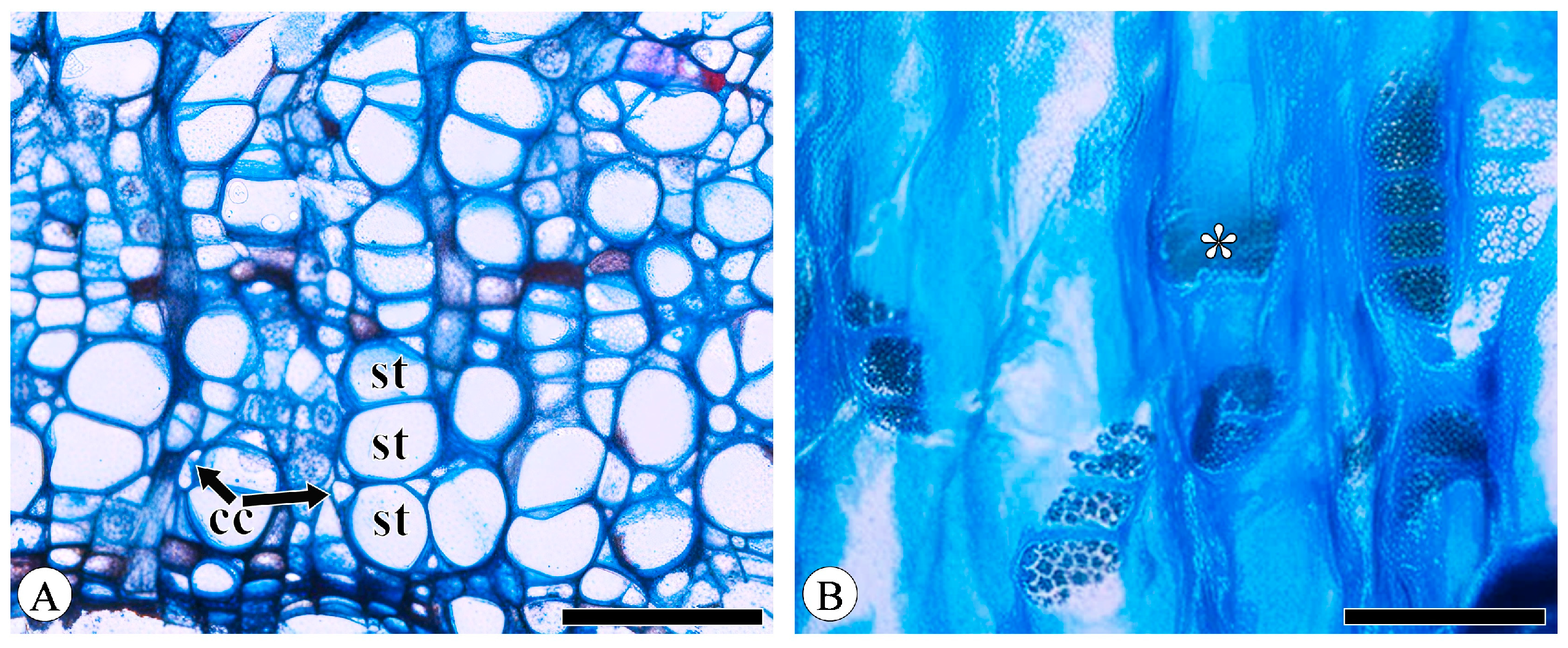
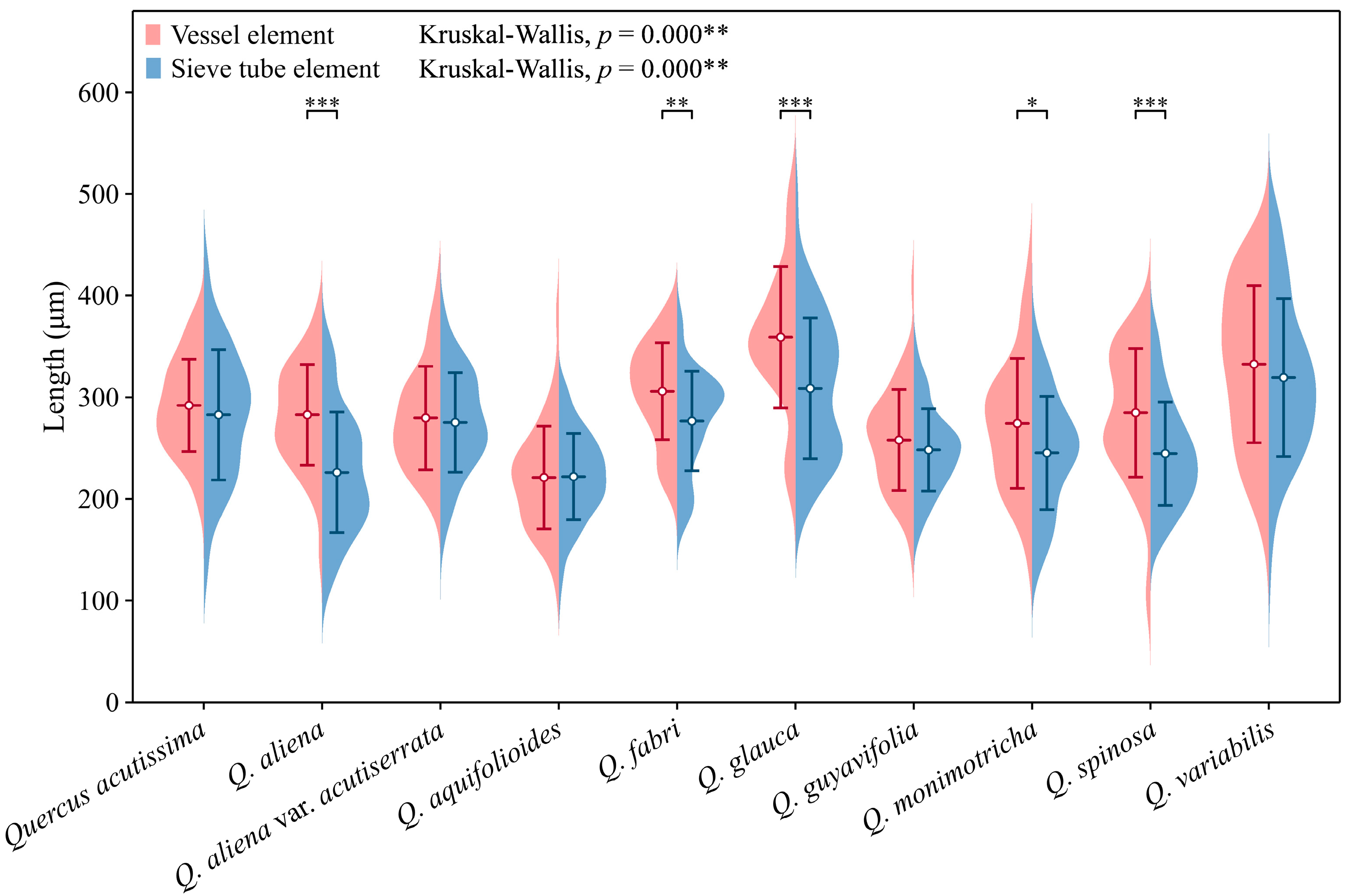

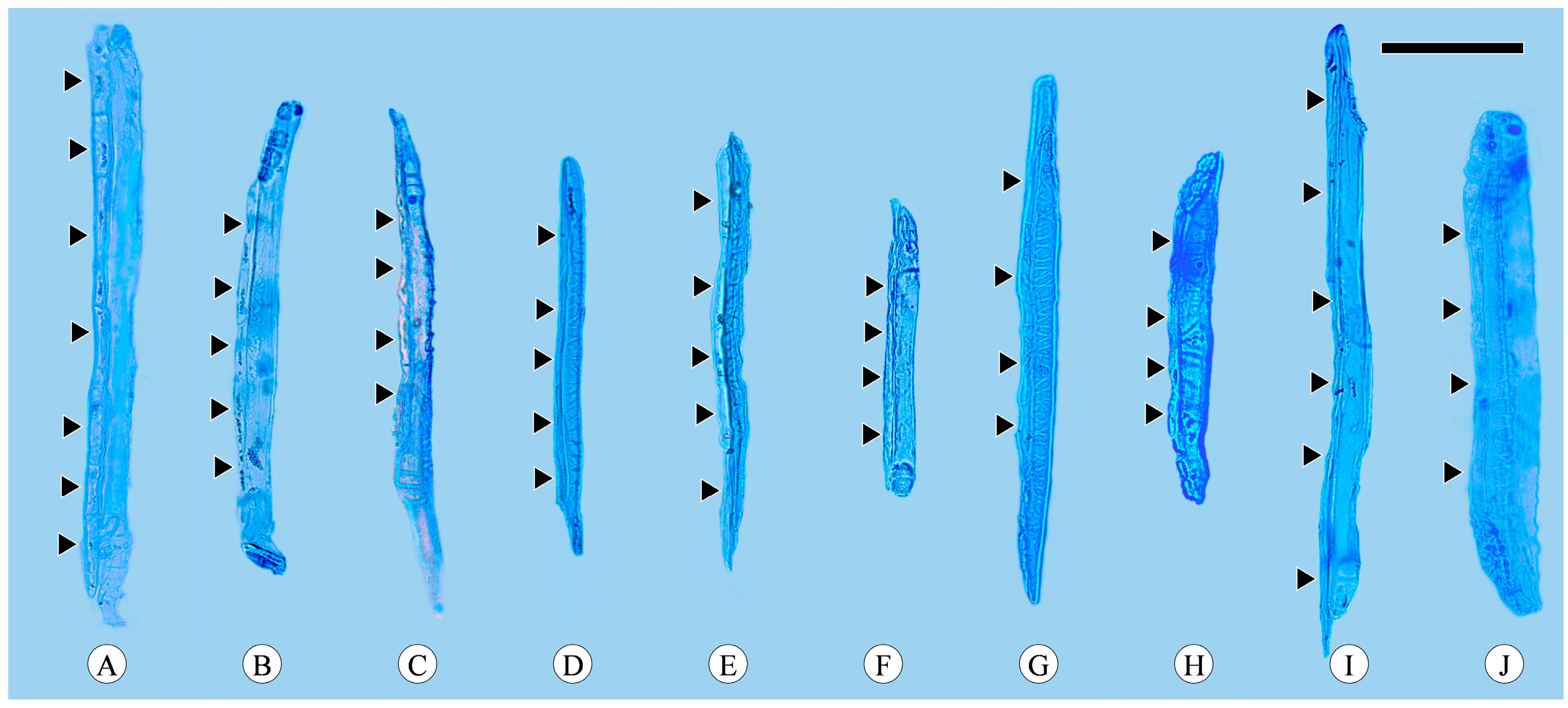

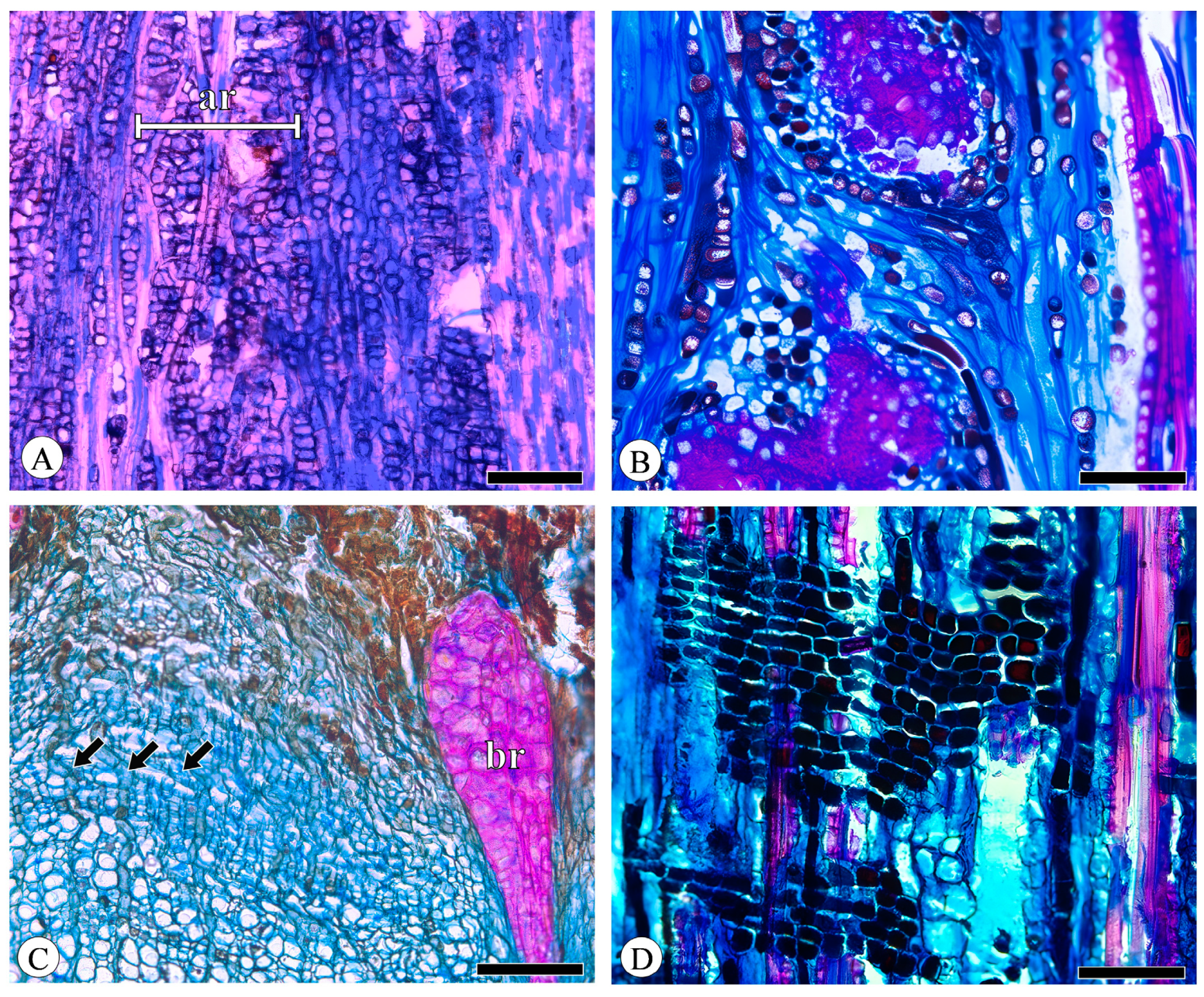
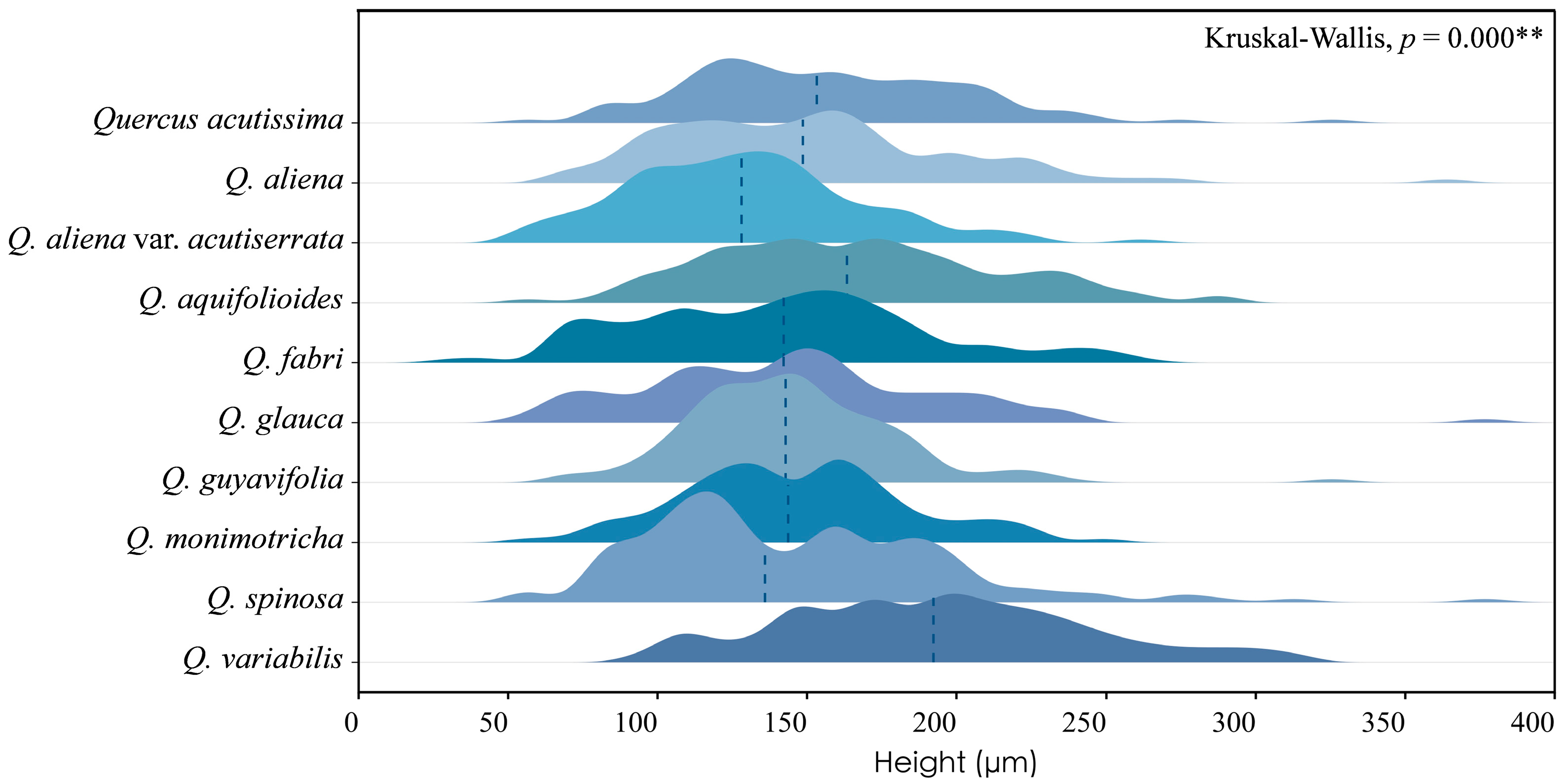


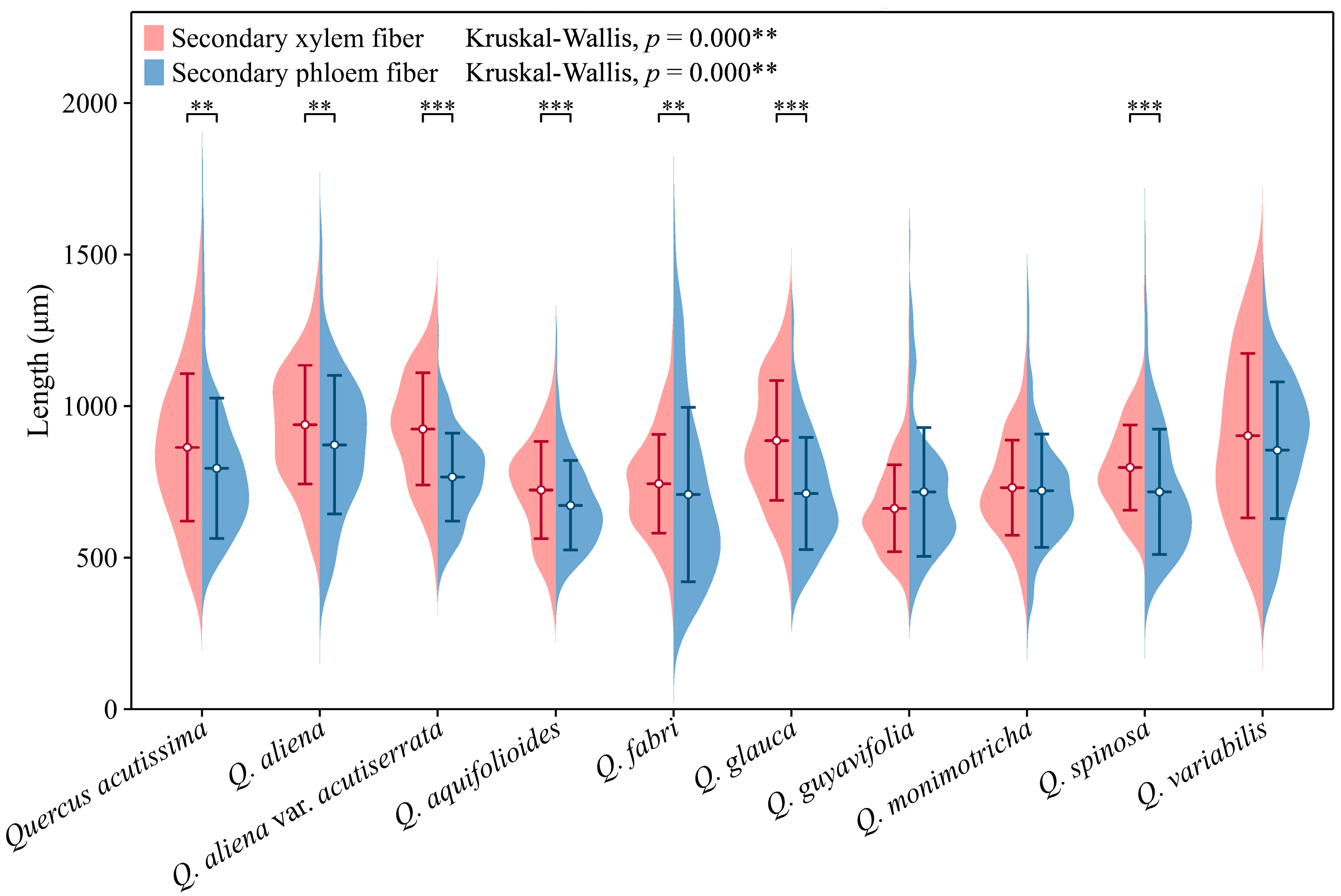

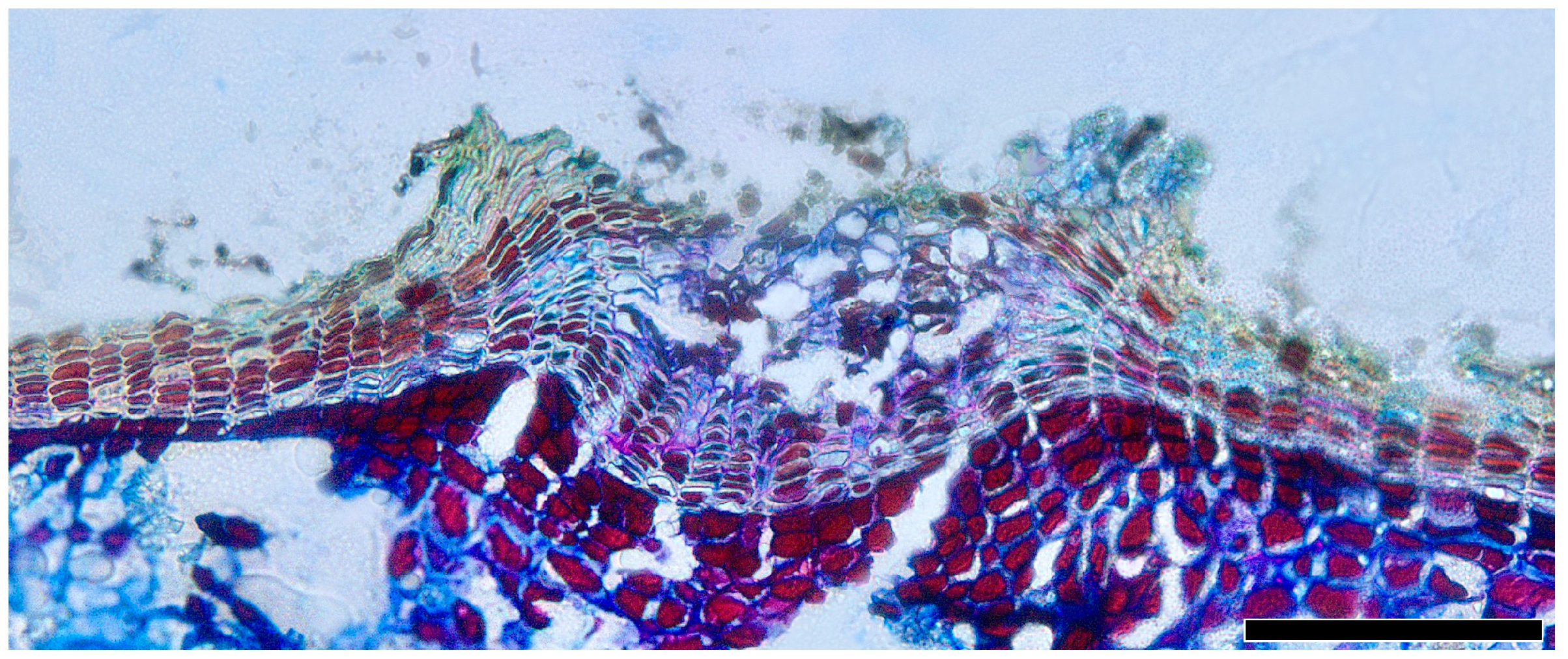
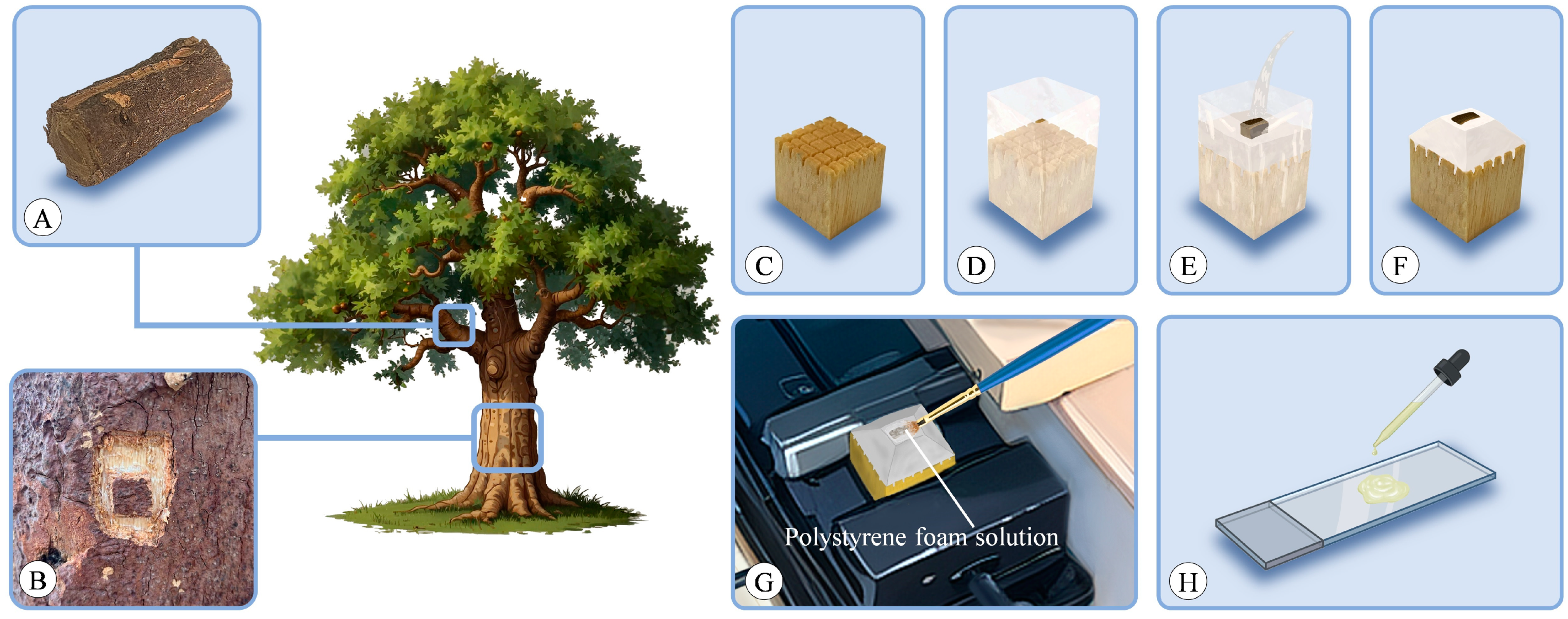
| Species | IAWA Codes | |
|---|---|---|
| Qualitative Features | Quantitative Features | |
| Quercus acutissima | 1 2 6 8 12 16 21 25 27 31 37 38 41 44 48 49 51 52 58 61 62 64 65 69 71 74 77 79 86 103 105 112 114 115 116 123 129 130 147 148 149 150 174 | 14: 168–622 μm2, 361 ± 109 μm2, n = 40 15: 131–432 μm, 283 ± 64 μm, n = 68 50: 62–321 μm, 157 ± 45 μm, n = 104 70: 421–1769 μm, 794 ± 231 μm, n = 147 |
| Q. aliena | 1 2 6 8 12 16 21 25 27 31 37 38 41 43 48 49 51 52 61 64 65 69 71 74 77 79 80 84 86 103 105 112 114 116 123 129 130 147 148 149 150 174 | 14: 67–400 μm2, 198 ± 74 μm2, n = 41 15: 112–362 μm, 226 ± 59 μm, n = 88 50: 66–358 μm, 150 ± 48 μm, n = 120 70: 345–1574 μm, 872 ± 228 μm, n = 203 |
| Q. aliena var. acutiserrata | 1 2 6 8 12 16 21 25 27 31 37 38 41 43 48 49 51 52 61 64 65 69 71 74 77 79 80 84 86 103 105 112 114 116 123 129 130 147 148 149 150 174 | 14: 87–438 μm2, 245 ± 88 μm2, n = 45 15: 160–382 μm, 275 ± 49 μm, n = 55 50: 56–257 μm, 130 ± 38 μm, n = 133 70: 459–1233 μm, 766 ± 145 μm, n = 118 |
| Q. aquifolioides | 1 2 6 8 12 16 21 25 27 31 37 38 41 43 45 52 58 61 64 65 69 71 74 77 80 84 86 103 105 112 114 116 123 129 130 147 148 149 150 174 | 14: 110–407 μm2, 242 ± 65 μm2, n = 46 15: 99–315 μm, 222 ± 43 μm, n = 135 50: 61–290 μm, 166 ± 47 μm, n = 122 70: 382–1238 μm, 673 ± 148 μm, n = 145 |
| Q. fabri | 1 2 6 8 12 16 21 25 27 31 37 38 41 43 48 49 51 52 61 64 65 69 71 74 77 79 80 84 86 103 105 112 114 116 123 129 130 147 148 149 150 174 175 | 14: 69–243 μm2, 134 ± 36 μm2, n = 50 15: 185–374 μm, 277 ± 49 μm, n = 36 50: 33–267 μm, 140 ± 48 μm, n = 125 70: 301–1607 μm, 708 ± 288 μm, n = 140 |
| Q. glauca | 1 2 6 8 12 16 21 25 27 31 37 38 41 43 48 49 51 52 61 64 65 69 71 74 77 80 84 86 103 105 112 114 115 116 123 129 130 147 148 149 150 174 | 14: 90–390 μm2, 178 ± 52 μm2, n = 59 15: 191–497 μm, 309 ± 69 μm, n = 54 50: 53–371 μm, 144 ± 49 μm, n = 113 70: 365–1300 μm, 712 ± 185 μm, n = 187 |
| Q. guyavifolia | 1 2 6 8 12 16 21 25 27 31 37 38 41 43 48 49 51 52 61 64 65 69 71 74 77 80 84 86 103 105 112 114 115 116 123 129 130 147 148 149 150 174 175 | 14: 100–376 μm2, 176 ± 56 μm2, n = 44 15: 162–348 μm, 248 ± 40 μm, n = 55 50: 71–325 μm, 145 ± 35 μm, n = 132 70: 345–1551 μm, 717 ± 213 μm, n = 136 |
| Q. monimotricha | 1 2 6 8 12 16 21 25 27 31 37 38 41 43 48 49 51 52 61 64 65 69 71 74 77 79 80 84 86 103 105 112 114 116 123 129 130 147 148 149 150 175 | 14: 158–386 μm2, 270 ± 51 μm2, n = 47 15: 129–366 μm, 245 ± 56 μm, n = 62 50: 62–253 μm, 146 ± 37 μm, n = 116 70: 253–1408 μm, 721 ± 187 μm, n = 213 |
| Q. spinosa | 1 2 6 8 12 16 21 25 27 31 37 38 41 43 48 49 51 52 61 64 65 69 71 74 77 80 84 86 103 105 112 114 116 123 129 130 147 148 149 150 174 175 | 14: 63–477 μm2, 204 ± 83 μm2, n = 81 15: 163–366 μm, 245 ± 51 μm, n = 60 50: 55–375 μm, 146 ± 51 μm, n = 161 70: 375–1513 μm, 717 ± 207 μm, n = 140 |
| Q. variabilis | 1 2 6 8 12 16 21 25 27 31 37 38 41 44 48 49 51 52 61 62 64 65 69 71 74 77 79 86 103 105 112 115 116 123 129 130 147 148 149 150 174 | 14: 448–1370 μm2, 867 ± 235 μm2, n = 46 15: 117–488 μm, 319 ± 78 μm, n = 116 50: 90–317 μm, 193 ± 50 μm, n = 132 70: 379–1392 μm, 854 ± 225 μm, n = 116 |
Disclaimer/Publisher’s Note: The statements, opinions and data contained in all publications are solely those of the individual author(s) and contributor(s) and not of MDPI and/or the editor(s). MDPI and/or the editor(s) disclaim responsibility for any injury to people or property resulting from any ideas, methods, instructions or products referred to in the content. |
© 2024 by the authors. Licensee MDPI, Basel, Switzerland. This article is an open access article distributed under the terms and conditions of the Creative Commons Attribution (CC BY) license (https://creativecommons.org/licenses/by/4.0/).
Share and Cite
Li, C.; Yang, X.; Chen, S.; Huang, Y.; Yang, Y.; Qiu, J. Comparative Anatomical Analysis of Bark Structure in 10 Quercus Species. Plants 2024, 13, 1871. https://doi.org/10.3390/plants13131871
Li C, Yang X, Chen S, Huang Y, Yang Y, Qiu J. Comparative Anatomical Analysis of Bark Structure in 10 Quercus Species. Plants. 2024; 13(13):1871. https://doi.org/10.3390/plants13131871
Chicago/Turabian StyleLi, Changzhao, Xiaorui Yang, Songyang Chen, Yuxi Huang, Yushan Yang, and Jian Qiu. 2024. "Comparative Anatomical Analysis of Bark Structure in 10 Quercus Species" Plants 13, no. 13: 1871. https://doi.org/10.3390/plants13131871
APA StyleLi, C., Yang, X., Chen, S., Huang, Y., Yang, Y., & Qiu, J. (2024). Comparative Anatomical Analysis of Bark Structure in 10 Quercus Species. Plants, 13(13), 1871. https://doi.org/10.3390/plants13131871





